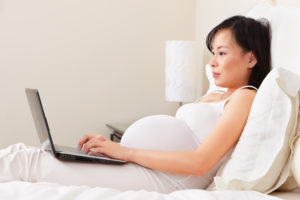My Second Trimester
Week 15
Estimated reading time: 5 min reads Your baby’s skeleton is busy amassing bones visible at your Week 20 ultrasound. The outline of your baby’s hair and eyebrows are evident. The pigments that color your baby’s hair are now being produced. The skin is exceptionally fragile and maturing at this time.
Your baby’s skeleton is busy amassing bones visible at your Week 20 ultrasound. The outline of your baby’s hair and eyebrows are evident. The pigments that color your baby’s hair are now being produced. The skin is exceptionally fragile and maturing at this time.
Your baby is probably about 4½ inches from head to rump, about the size of a sweet Vidalia onion, and weighs only 2 to 3 ounces in your fifteenth week of pregnancy.
Sleep Position and Sleep
 Should you be sleeping on your left side when pregnant?
Should you be sleeping on your left side when pregnant?
There are pros and cons. According to BabyCenter Sleep Expert, Donna Arand, Ph.D., Clinical Director of the Kettering Sleep Disorders Center and Associate Research Professor in Neurology at the Boonshoft School of Medicine at Wright State University explains:
- “Sleeping on your side is best while you’re pregnant. In particular, sleeping on your left side may benefit your baby by improving blood flow – and therefore nutrients – to the placenta. It also helps your kidneys efficiently eliminate waste products and fluids from your body, which in turn reduces swelling in your ankles, feet, and hands.
- It’s a good idea to start training yourself early in pregnancy to sleep on your left side whenever you can. Of course, staying in one position all night isn’t likely to be comfortable, so turning from side to side while favoring your left side is probably the best strategy.
- As for sleeping on your back, avoid that position throughout pregnancy, especially in the later months. Here’s why:
- When you’re sleeping on your back, the weight of your uterus lies on the spine, back muscles, intestines, and major blood vessels. This can lead to muscle aches and pains, hemorrhoids, and impaired circulation, which is uncomfortable for you and can reduce circulation to your baby.
- Back sleeping can make blood pressure drop, causing some expectant moms to experience dizziness. On the other hand, in some moms-to-be it can make blood pressure go up.
- Finally, back sleeping can cause snoring and, with increased weight, could lead to sleep apnea.”
 There is a debate as to which position is best for sleep when pregnant according to Dr. Collins. Should you take the position of the placenta into account? What if the placenta is positioned on the left side of the uterus?
There is a debate as to which position is best for sleep when pregnant according to Dr. Collins. Should you take the position of the placenta into account? What if the placenta is positioned on the left side of the uterus?
The safest thing for you to do is to check with your health care team and see what position they recommend is best for you.
Did you know some pregnant women prefer an air bed for comfort? Air beds provide an adjustable technology creating a desired firmness or softness that accommodates a mom’s changing weight, dimensions and comfort levels. For more information on pregnancy and sleep, please visit BabyCenter and the National Sleep Foundation.
Incompetent Cervix
 An Incompetent Cervix, also called Cervical Insufficiency, or CI, is a condition of pregnancy that occurs when the expectant mother’s cervical tissue is weakened to such a degree that it may lead to an unexpected pregnancy loss. This may be due to a previous childbirth, cervical trauma such as a broad cervical conization (cervical biopsy), various abnormalities and irregularities of the uterus, the possible exposure to the synthetic estrogen Diethylstilbestrol (DES), or there may be no defining cause. CI can cause or contribute to premature birth, and in many cases, the loss of an otherwise robust pregnancy. While CI occurs in only one out of 100 pregnancies, the condition is responsible for approximately 25 percent of losses in the second trimester.
An Incompetent Cervix, also called Cervical Insufficiency, or CI, is a condition of pregnancy that occurs when the expectant mother’s cervical tissue is weakened to such a degree that it may lead to an unexpected pregnancy loss. This may be due to a previous childbirth, cervical trauma such as a broad cervical conization (cervical biopsy), various abnormalities and irregularities of the uterus, the possible exposure to the synthetic estrogen Diethylstilbestrol (DES), or there may be no defining cause. CI can cause or contribute to premature birth, and in many cases, the loss of an otherwise robust pregnancy. While CI occurs in only one out of 100 pregnancies, the condition is responsible for approximately 25 percent of losses in the second trimester.
Before you become pregnant, your cervix is normally closed and firm. As your pregnancy advances and you prepare for delivery day, the cervix gradually relaxes, shortens in length (effaces) and opens (dilates). If your cervix is incompetent, it might begin to open ahead of time and you may deliver your baby too early without even feeling any contractions. CI usually manifests between Weeks 16-24, with most instances taking place between Weeks 18-22.
It is difficult to diagnose CI and because of this, it is difficult to treat. A manual pelvic examination may detect CI. For a diagnosis of CI to be made, the cervical opening must be greater than 2.5 cm, or the cervical length must have shortened to less than 20mm. Funneling, a shortening of the cervix and dilatation of the internal cervical canal, can also be a sign of CI.
A transvaginal ultrasound is the best technique to examine the cervix according to Dr. James E. Sumners, M.D., of St. Vincent Women’s Center for Prenatal Diagnosis in Indianapolis. This specialized ultrasound helps monitor cervical length and can check to see if the cervix is opening. This method visualizes the entire cervix and the complete cervical canal. Once diagnosed, preventative medication, repeated ultrasounds, or various techniques for closing the cervix may be implemented such as a cervical cerclage, a purse-string stitch that acts as an cinch to keep the cervix from dilating. This is usually performed in an outpatient setting between Weeks 12-15.
Unfortunately, during pregnancy you may not experience or feel any signs or symptoms that your cervix is beginning to open too early. You could possibly notice some minor discomfort or vaginal spotting over several days or perhaps weeks. You should alert your health care team if you notice any of the following between Weeks 14-20: pelvic pressure, a backache, mild abdominal cramping and a variation in your vaginal discharge such as mucous or blood.
Women who have already had a miscarriage because of incompetent cervix will likely have the same outcome in future pregnancies if they do not seek treatment. Not seeking treatment can lead to great stress and emotional suffering for women and couples hoping to become parents.
To find out more information on diagnosis, treatment or understanding how CI may impact your pregnancy, please visit the March of Dimes and The University of Chicago Hospitals.